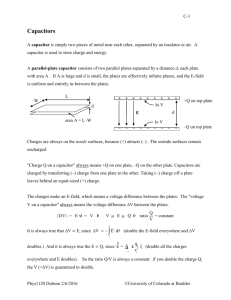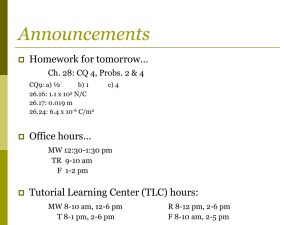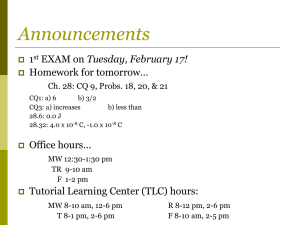18_lecture_acl
advertisement
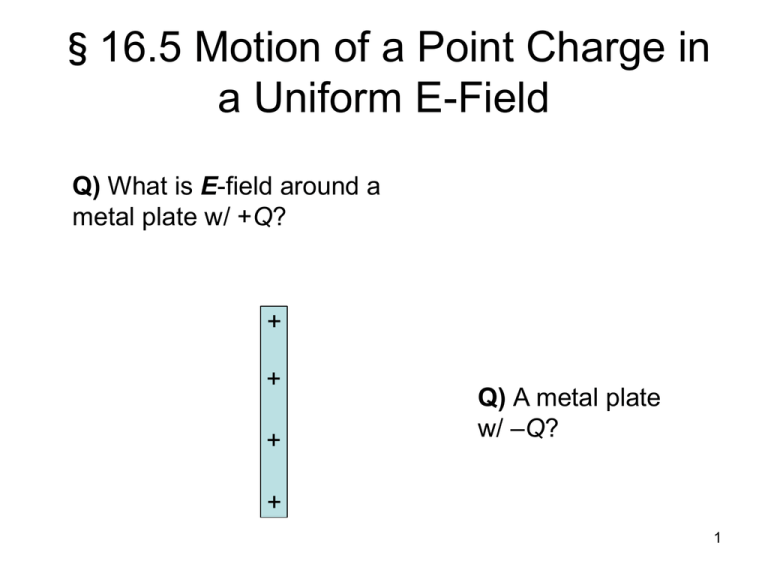
§16.5 Motion of a Point Charge in a Uniform E-Field Q) What is E-field around a metal plate w/ +Q? + + + Q) A metal plate w/ –Q? + 1 Parallel metal plates uniform E Fig. 16.34 Charge +q & mass m “Cathode Ray Tube” (TV) “Electron gun” q a E m E Charge +q & mass m. v at x 12 (v f v i )t Use kinematic equations w/ constant a from Ch. 4: x v it 12 at 2 v 2f v i2 2ax 4 Example: What electric field is needed to keep an electron suspended in the air against gravity? (a) Direction? (b) Strength? (c) Would a proton require the same field? Example (PP 16.48): An electron is placed in a uniform electric field of strength 232 N/C. If the electron is at rest at the origin of a coordinate system at t = 0 and the electric field is in the positive direction, what are the x- and y-coords of the electron at t = 2.3 ns? The velocity? 5 §16.6 Conductors in Electrostatic Equilibrium • Conductors are easily polarized: free electrons move around freely inside the material. • Any charges placed on a conductor will arrange themselves in a stable, unmoving distribution: electrostatic equilibrium. • For a conductor in electrostatic equilibrium: 1) The E-field inside it is zero (no field lines) 2) Any net charge must reside on the surface 3) Just outside the surface, E is perpendicular to the surface 4) Any excess charge will accumulate where the surface is highly curved (i.e. a sharp point): E is strongest there. 6 Put 16 nC on the following surface: Q) Where will charges go? Q) What will the E-field look like? Lightning rod 7 Chapter 18: Electric Potential • Electric Potential Energy • Electric Potential (Voltage) • How are the E-field and Electric Potential related? • Motion of Point Charges in an E-field • Capacitors • Dielectrics More help: SPS drop in MW 8:30-9:30am Canvas goodies TR 11am-noon 178 Overman Hall For Wed recitation: • do Online Problems (WA) • do Practice Problems: Ch 17 #45, 87 Ch 18 tbd Lab: 2.03 (vsound) this week • Read instructions • Do Pre-Lab & turn in • Quiz #1 (Ch 13, 17, 18) Wed Sep 18 during recitation (indiv, group) 8 §17.1 Electric Potential Energy Electric potential energy (PEe) is: • energy stored in the electric field, kq1q2 PEe r • work (W=F.d) done to put charges in place. PEg mgh +Q +Q h m +q -q 9 Example: Two point charges, Q = +6.0 mC and q = +5.0 mC are separated by 15.0 m. (a) What is their potential energy? (b) If Q is fixed and q is free to move, what will q do? (c) How does q’s motion affect the potential energy? Explain in terms of conservation of energy. 10 Q) What is the potential energy of three point charges arranged as a right triangle? kq1q2 PE12 r12 q2 r23 r12 q1 kq1q3 PE13 r13 q3 r13 PE23 kq2q3 r23 Q) What if there are four charges? PEtot PEi PE12 PE13 PE23 ... (scalar sum) 11 §17.2 Electric Potential Electric potential is the electric potential energy per unit charge: PE e V qtest For a point charge Q: • scalar • 1 V = 1 J/C. PEe kQ V qtest r When a charge q moves through a potential difference of V, its potential energy change is PEe = qV. 12 Example: A charge Q = +1 nC is placed somewhere in space far from other charges. Take ra = rb = rc = rd = 1.0 m and re = rf = rg = 2.0 m. f (a) Compare the potential at points d and g. b c e a Q d g (b) Compare the potential at points a and b. 13 Example: A charge Q = +1 nC is placed somewhere in space far from other charges. Take ra = rb = rc = rd = 1.0 m and re = rf = rg = 2.0 m. (c) Place a charge of +0.50 nC at point e. What will the change in potential (V) be if this charge is moved to point a? f b c e a Q d g (d) What is the change in potential energy (PE) of the +0.50 nC charge ? 14 §17.3 The Relationship between E and V Equipotentials: surfaces of equal potential. f b c e a Q +9 V +4.5 V d g 15 E points in direction of maximum potential decrease. E is perpendicular to the equipotential surfaces. f b c E e a Q +9 V +4.5 V d g Q) What is V at 3m? At 0.5 m? 16 Fig. 17.19 Q: What do the equipotentials look like around a – charge? Equipotentials and field lines for a dipole: 18 Uniform E-field: V1 V2 V3 V4 E Equipotential surfaces U e V Ed q Where d is the distance over which V occurs. 19 Example: Two parallel plates are separated by 2.0 mm. One is at a potential of 3000.0 V while the other is at 0.0 V. What is the E-field between them? Q) Why is E negative? 20 Hollow Conducting Sphere (radius = R): (Similar for other hollow shapes) Van de Graaff generator 22 §17.4 Moving Charges When only electric forces act on a charge, its total mechanical energy, E, will be conserved: Ei E f K i Ui K f U f 23 Example (PP 17.40): Point P is at a potential of 500.0 kV and point S is at a potential of 200.0 kV. The space between these points is evacuated. When a charge of +2e moves from P to S, by how much does its kinetic energy change? (b) If the particle has a mass of 2.0x10-9 kg and starts from rest at P, what is its speed at S? 24 Example (text problem 17.41): An electron is accelerated from rest through a potential difference. If the electron reaches a speed of 7.26106 m/s, what is the potential difference? 25 Chapter 17: Electric Potential • Electric Potential Energy • Electric Potential • How are the E-field and Electric Potential related? • Motion of Point Charges in an E-field • Capacitors • Dielectrics Free Tutoring & Study See BlackBoard/C.I. Practice Exam on BB For Mon recitation: • do Online Problems • do Practice Problems: • Ch 17 (pp.634-7) 42, 70, 83, 87, 91 Lab: 2.04 (E-field) this week • Read instructions • Do Pre-Lab & turn in • 2.05 (Current) next week • Exam #1 (Ch 12, 16, 17) Wed Sep 12, 7:30-8:45pm, 26 095 Overman Hall §17.5 Capacitors A capacitor stores electric potential energy by storing separated (+) and (–) charges. Work must be done to separate the charges. + + + + + + + Parallel plate capacitor – – – – – – – Why? 27 Fig. 17.22 + + + + + + + V – – – – For a parallel plate capacitor: – – – EQ E V Q V Or Q = CV where the proportionality constant C = capacitance [ Farad = C/V ] 30 What is the capacitance for a parallel plate capacitor? Q V Ed (4 k )d 4 k d A A Q V CV 4 kd A where C . 4 kd Note: C is a property of the device, • it depends on A & d, • “capacity” to hold charge. 31 Example (PP 17.56): A parallel plate capacitor has a capacitance of 1.20 nF. There is a charge of magnitude 0.800 mC on each plate. (a) What is the potential difference between the plates? (b) If the plate separation is 0.3 mm, what is the area? (c) If the plate separation is doubled while the charge is kept constant, what will happen to the potential difference, and to the potential energy stored in the capacitor? 32 §17.6 Dielectrics + + + + + + + – – – – – – – I. Air-filled capacitor: Increase Q increase E Atoms in air b/w plates gets polarized: Eventually electrons pulled off (ionized), Charge arcs across gap = “breakdown” Need a better insulator! dielectric strength (kV/mm) 33 + + + + + + + – – – – – – – II. Add a dielectric w/ dielectric constant k Atoms polarize Charge separation at ends Reduces E inside dielectric Can add more Q to plates Higher C = Q/V A C k kC0 4kd 34 Example (PP 17.71): A capacitor can be made from two sheets of aluminum foil separated by a sheet of waxed paper. If the sheets of aluminum are 0.3 m by 0.4 m and the waxed paper, of slightly larger dimensions, is of thickness 0.030 mm and has k = 2.5, (a) what is the capacitance of this capacitor? (b) How much charge can it hold before breakdown? (c) How much energy is stored at this point? 36 McGuiver?! §17.7 Energy Stored in a Capacitor A capacitor will store energy equivalent to the amount of work that it takes to separate the charges. 37 The energy stored in the electric field between the plates is: 1 U QV 2 1 2 C V 2 Q2 2C } (Sub in Q = CV) Summary: • C is set by the device (A, d, k) • V is set by the strength of the battery (“pump”) • Q and U depend on C and V. 38 Example (PP 17.79): A parallel plate capacitor is composed of two square plates, 10.0 cm on a side, separated by an air gap of 0.75 mm. (a) What is the charge on this capacitor when the potential difference is 150 volts? (b) What energy is stored in this capacitor? 39 Summary •Electric Potential Energy •Electric Potential •The Relationship Between E and V •Motion of Point Charges (conservation of energy) •Parallel Plate Capacitors (capacitance, dielectrics, energy storage) 40 §16.6 Conductors in Electrostatic Equilibrium • Conductors are easily polarized: free electrons move around freely inside the material. • Any charges placed on a conductor will arrange themselves in a stable, unmoving distribution: electrostatic equilibrium. • For a conductor in electrostatic equilibrium: 1) The E-field inside it is zero (no field lines) 2) Any net charge must reside on the surface 3) Just outside the surface, E is perpendicular to the surface 4) Any excess charge will accumulate where the surface is highly curved (i.e. a sharp point): E is strongest there. 41 Put 16 nC on the following surface: Q) Where will charges go? Q) What will the E-field look like? Lightning rod 42

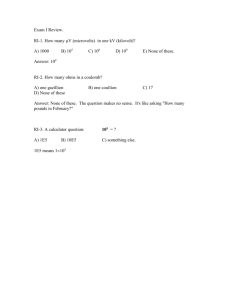
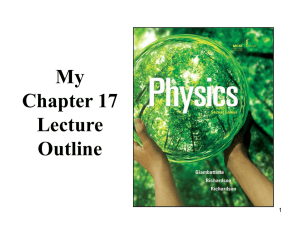
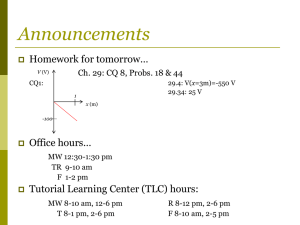
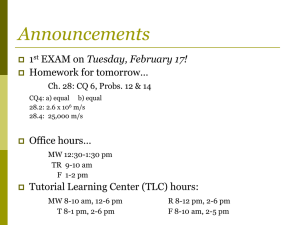
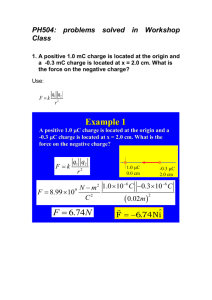
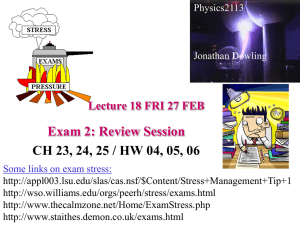
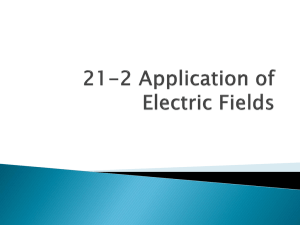
![Sample_hold[1]](http://s2.studylib.net/store/data/005360237_1-66a09447be9ffd6ace4f3f67c2fef5c7-300x300.png)
